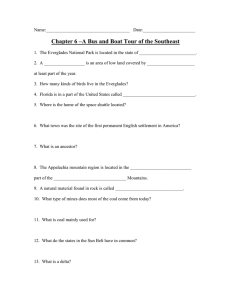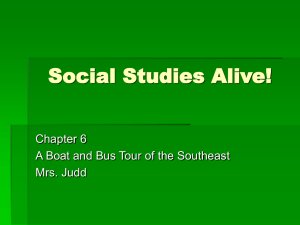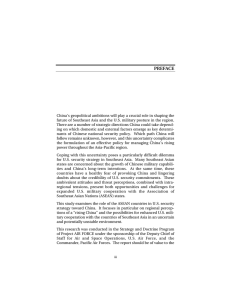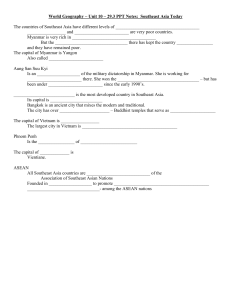Southeast Study Guide Swamp: Tributary:
advertisement
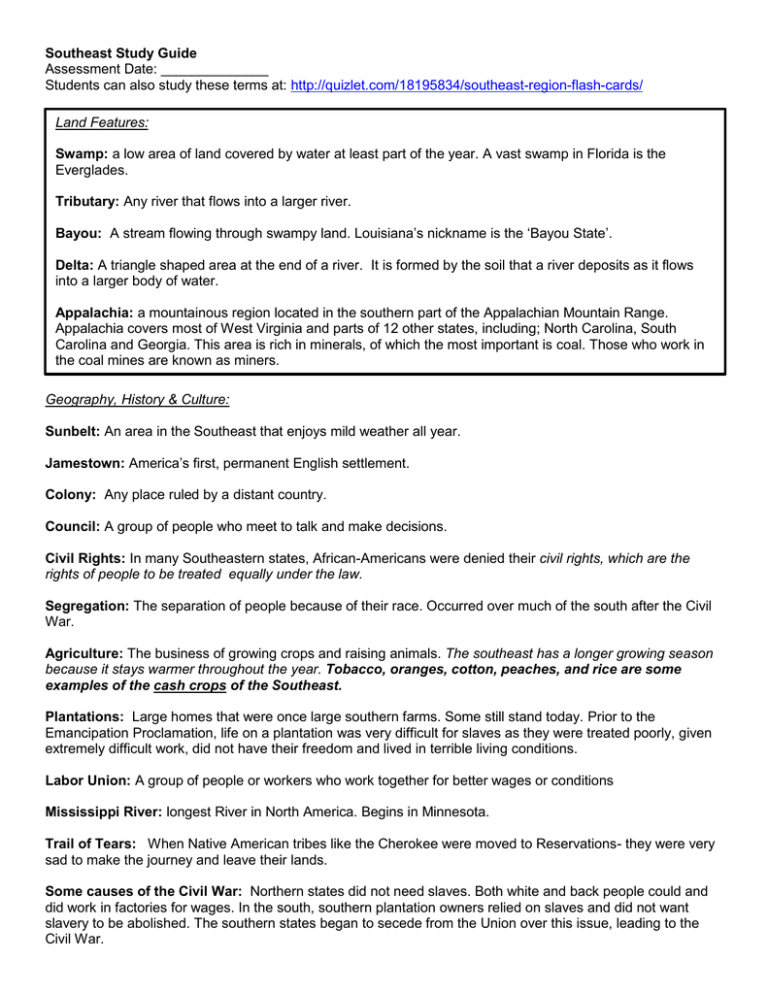
Southeast Study Guide Assessment Date: ______________ Students can also study these terms at: http://quizlet.com/18195834/southeast-region-flash-cards/ Land Features: Swamp: a low area of land covered by water at least part of the year. A vast swamp in Florida is the Everglades. Tributary: Any river that flows into a larger river. Bayou: A stream flowing through swampy land. Louisiana’s nickname is the ‘Bayou State’. Delta: A triangle shaped area at the end of a river. It is formed by the soil that a river deposits as it flows into a larger body of water. Appalachia: a mountainous region located in the southern part of the Appalachian Mountain Range. Appalachia covers most of West Virginia and parts of 12 other states, including; North Carolina, South Carolina and Georgia. This area is rich in minerals, of which the most important is coal. Those who work in the coal mines are known as miners. Geography, History & Culture: Sunbelt: An area in the Southeast that enjoys mild weather all year. Jamestown: America’s first, permanent English settlement. Colony: Any place ruled by a distant country. Council: A group of people who meet to talk and make decisions. Civil Rights: In many Southeastern states, African-Americans were denied their civil rights, which are the rights of people to be treated equally under the law. Segregation: The separation of people because of their race. Occurred over much of the south after the Civil War. Agriculture: The business of growing crops and raising animals. The southeast has a longer growing season because it stays warmer throughout the year. Tobacco, oranges, cotton, peaches, and rice are some examples of the cash crops of the Southeast. Plantations: Large homes that were once large southern farms. Some still stand today. Prior to the Emancipation Proclamation, life on a plantation was very difficult for slaves as they were treated poorly, given extremely difficult work, did not have their freedom and lived in terrible living conditions. Labor Union: A group of people or workers who work together for better wages or conditions Mississippi River: longest River in North America. Begins in Minnesota. Trail of Tears: When Native American tribes like the Cherokee were moved to Reservations- they were very sad to make the journey and leave their lands. Some causes of the Civil War: Northern states did not need slaves. Both white and back people could and did work in factories for wages. In the south, southern plantation owners relied on slaves and did not want slavery to be abolished. The southern states began to secede from the Union over this issue, leading to the Civil War. Prominent People who helped lead the Civil Rights movement in the Southeast: Rosa Parks: who was arrested by not giving up her seat on a bus to a white man. This led to a city-wide boycott which led to the law being changed. Martin Luther King Jr: An inspiring community leader from Atlanta who led nonviolent protests, national marches and delivered the famous “I have a dream” speech. Natural Resources of the Southeast: Land Growing Industries (such as agriculture and animal raising) Long growing season Coal (found under the ground- used for fuel, energy and electricity) Iron Ore-used to make steel Forests: saw and paper mills make paper and furniture Dangerous Weather: Floods: a flood plain is a low, flat land along a river. Hurricanes: Form over the Atlantic Ocean in the summer. Reasons for settling in the Southeast African Americans came involuntarily as slaves. To find work Pleasant Climate Tourism industry provides jobs Fertile soil
